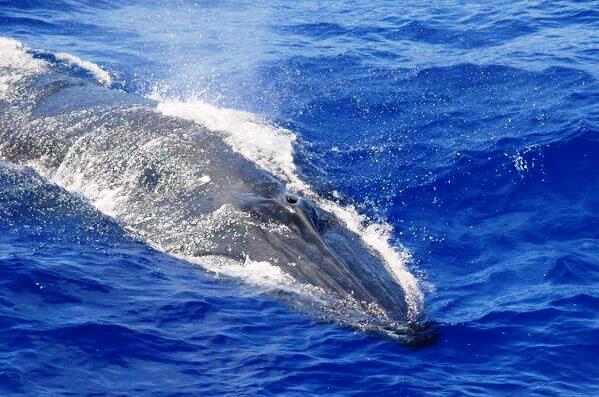The taxonomic classification of whales continues to evolve as marine biologists glean new insights from investigations of the largest of all animals on Earth. Two recent whale discoveries—one concerning a new species, and the other dealing with assignment of a previously unknown population or subspecies—show just how much more there is to learn about these marine mammals. Whales are cetaceans—that is, they belong to the taxonomic group Cetacea (which is considered to be a mammalian order or infraorder, depending on the classification scheme). Taxonomists divide living cetaceans into two broad categories: Odontoceti, or toothed whales (including dolphins and porpoises), which possess teeth; and Mysticeti, or baleen whales, which are toothless filter-feeders that strain water filled with clouds of marine animals (especially krill) through a network of baleen—a keratinlike substance that hangs down in plates from the whale's upper jaws. The two newly identified types of cetaceans involve baleen whales—specifically, a rorqual whale inhabiting the Gulf of Mexico and a blue whale found in the Indian Ocean. See also: Biological classification; Cetacea; Speciation; Taxonomy

Bryde's whale (Balaenoptera edni or B. brydei) has a worldwide distribution, ranging throughout the Atlantic, Pacific, and Indian oceans. This whale is named after Johan Bryde, who created the first modern whaling station in South Africa in the late 1800s. With an estimated population size of 90,000 to 100,000 individuals, Bryde's whales have been well studied. However, one particularly small group of Bryde's whales living in deep waters of the northeastern Gulf of Mexico exhibits atypical behaviors compared to other Bryde's whales. Whereas most baleen whales undertake long-distance seasonal migrations, the population located in the Gulf of Mexico does not migrate, instead remaining year-round in the waters between Louisiana and western Florida. In addition, the Gulf of Mexico population demonstrates different feeding behaviors than other Bryde's whales. Most Bryde's whales feed near the surface, whereas the Gulf of Mexico population prefers to feed in the deep ocean. With these anomalous behaviors, marine researchers entertained the possibility that the latter whales constituted a subspecies of Bryde's whale. However, genetic and observational investigations, including studies conducted on the skeletal remains and DNA of one exceptionally preserved beached whale, have determined conclusively that the population in the Gulf of Mexico comprises a completely new species—Rice's whale (B. ricei), named after Dale W. Rice, who, in the 1960s, was the first biologist to identify this type of whale in the Gulf of Mexico. See also: Deoxyribonucleic acid (DNA); Gulf of Mexico; Migratory behavior
The other whale discovery concerns a new population, or subspecies, of blue whales (B. musculus) in the western Indian Ocean near Oman and Madagascar. Blue whales have a global distribution. Researchers have noted a handful of differing subspecies of blues whales in various regions of the world, including one subspecies in the Indian Ocean. This subspecies is known as B. m. indica and predominantly inhabits the northern Indian Ocean. However, a previously unknown or misidentified population of this whale grouping has now been recognized. Marine mammalogists often use whale songs as the basis for identification of whales because different whale populations have their own signature vocalizations. Thus, after noting and recording the unique whale vocalizations from a group of blue whales located in the western Indian Ocean, marine researchers believe that the group constitutes a new population of blue whales. Earlier researchers may have confused this western Indian Ocean population with the predominant population of the B. m. indica subspecies found in the northern Indian Ocean. Thus far, though, no genetic data have been collected, so scientists are unable to definitively determine if the blue whale population in the western Indian Ocean is indeed a new population. It is even possible that any forthcoming genetic evidence may identify these whales as comprising a new subspecies. See also: Animal communication; Indian Ocean
Offsetting these new discoveries is the survivability of both Rice's whales and the population of Indian Ocean blue whales. Rice's whale is considered to be a critically endangered animal, with probably fewer than 100 individual whales (possibly even as low as 33 individuals) in existence. This extremely low population size is particularly worrisome to marine conservationists, who fear that heavy commercialization of the Gulf of Mexico, with substantial cargo-ship traffic and high levels of oil drilling and exploration, will precipitate the ultimate extinction of Rice's whale species. The vulnerability of blue whales in the Indian Ocean also concerns marine biologists. Because of severe depletion from decades of whaling, the population in the western Indian Ocean is considered endangered. Hence, marine scientists hope that the discovery and highlighting of these new groups of whales will lead to conservation actions necessary to adequately preserve these marine mammals. See also: Conservation of species; Endangered species; Extinction





